New destinations, new experiences, new learning opportunities. As we seeks to open up new destinations for schools it seemed only right our Product Manager and Regional Account Manager, Cristina, went out to explore one of our newest additions – Valencia!
Having developed an itinerary that picks upon a number of cross-curricular links, my Product Manager proposed the idea of venturing to the south-eastern ‘Orange Blossom Coast’.
Encompassing a range of activities to suit various Key Stages, the tour alone was enough to spark my interest. Never one to pass up on a travelling opportunity, I grabbed the chance to join my Product Manager on a journey to explore this vibrant city and better understand how our Valencia school tour can work for our groups.
Something to learn at every corner
Leaving on an early January morning, I did not find it difficult to say “goodbye” to the typical rainy English weather. Perfectly aware of the warmer climate expected along the Mediterranean, we couldn’t quite expect how wonderful it would actually be upon arriving at the terminal of Valencia Airport in Manises. 20 degrees, blue skies, and the sun beaming down like a pat on the back welcoming us to the city, along with our point of contact, David, from the Valencia Tourism Office.
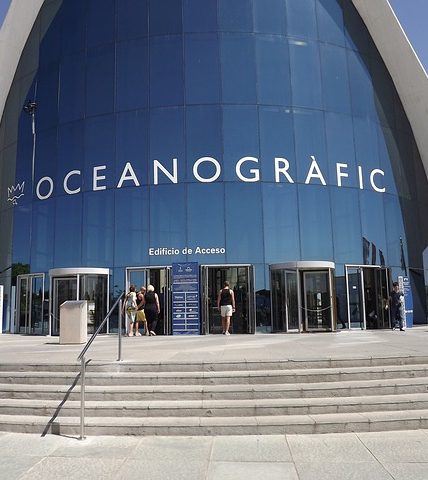
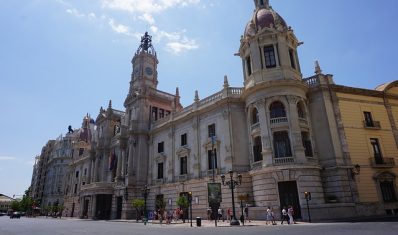
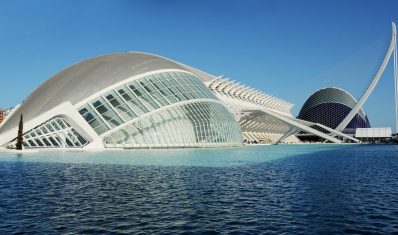
After dropping our luggage at the hotel where we were staying, we went straight to the city centre to experience a cycling tour of the old town, starting from the González Martí National Museum of Ceramics and Decorative Arts. This is contained within an extraordinary building, the baroque mansion of the Palacio del Marques de Dos Aguas. We then passed through Plaza del Ayuntamiento. Built in the 1920s, it has since changed its name four times. The three main buildings in the square are the post office, the city hall and the clock tower. At the base of the tower you can see a statue with two women crowned by a bat. The bat has been Valencia’s symbol since the 13th century when James I of Aragon was trying to conquer Valencia. It is said that, at the time under the power of the Moorish, a bat landed on his helmet. Since then, the bat has been seen as an omen for good luck echoed by the badges of the city’s two biggest football teams Valencia CF and Levante UD.
Picking up some bicycles, we rode through the old town where we often passed women in traditional medieval costumes on the street corners. They were rehearsing for Las Fallas, the biggest fiesta of the year in Valencia. Our guide explained to us that it is a very noisy, yet spectacular, festival relating to the ‘mascletá’. This is a daylight firework display set at 2 o’clock in the Plaza del Ayuntamiento every day during the festival.
The next stops of our tour were Plaza de la Virgen; the Cathedral; and La Lonja, a building originally used for trading in silk. We also passed through the Mercado Central, which was possibly one of my highlights of the cycling tour. The best time to go is mid-morning when it is bustling with people calling out their orders in Valencian, with baskets of fruit, vegetables, seafood and jamóneverywhere. Language in the Valencian Community is a special aspect of life with almost every citizen being bilingual. There are two official languages spoken: Valencian, which is very similar to Catalan, and then the classic Spanish, Castilian. It was particularly entertaining later in the evening when we were trying to get back to our accommodation. While our maps had the street names in Spanish, the actual street names on the buildings were in Valencian!
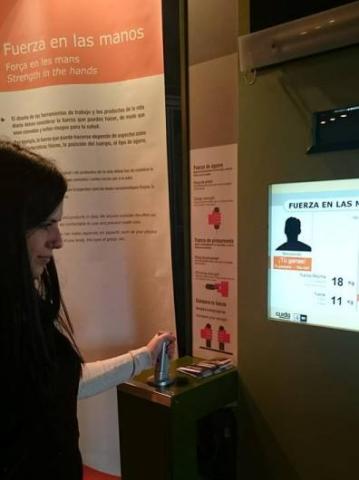
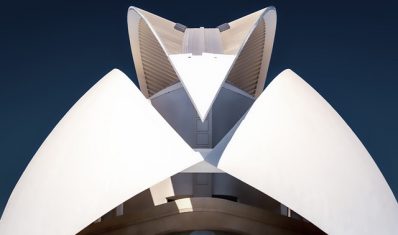
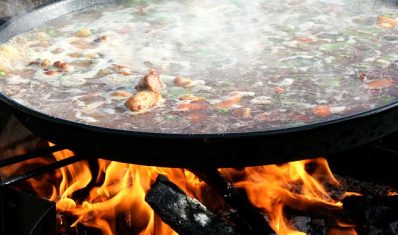
Our bicycle tour concluded by the Túria River. This may appear strange, but the city no longer stands on a river. After a disastrous flood in 1957, the government decide to divert the river along an artificial channel around the suburbs. Ingeniously, the river has been turned into an elongated ribbon of parks and sports fields crossed by a combination of historical and new bridges.
At the end of the tour we made our way to the seafront through the long and wide main avenue that connects the old town to the beach. For lunch, we couldn’t resist the paella, which we enjoyed in a lovely restaurant on the seafront. Surprisingly the paella we had was not made with rice as you would typically expect, but with short strands of spaghetti instead. Afterwards, we visited the Royal Marina that hosted the 32nd edition of the America’s Cup in 2007. Designed specifically for this event, the Royal Marina offers excellent wind and wave conditions, a range of modern facilities, and the potential to see further development.
On our way back to the hotel, we had smiles on our faces as we glanced up to see the big temperature screen across the street still showing 19 degrees even at 8 o’clock in the evening. We simply had to grab a picture otherwise nobody would ever believe we had weather this great in late January!
Uncovering Spanish science spectacular
The next day, after a rich breakfast buffet, we headed to the City of Science and Arts (Ciutat de les Arts i les Ciències). This ambitious complex aims to encourage visitors to combine leisure with an exploration of the arts, science and nature. It consists of five stunningly futuristic buildings with four of them designed by the neofuturistic architect, Santiago Calatrava.
The first building we visited was the Science Museum (Museu de les Ciències Príncipe Felipe) featuring exhibitions arranged on 4 floors. Focused on life, earth, science and technology, the museum is filled with interactive exhibits which students and Party Leaders alike will love. Unfortunately we were unable to make it to Valencia’s incredible aquarium, L’Oceanogràfic, due to refurbishing works. However, we had the chance to speak with the Marketing Manager, Marta, who explained to us everything we wanted to know about the learning experience.
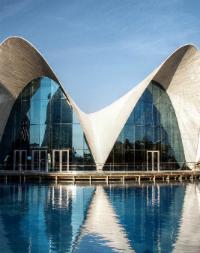
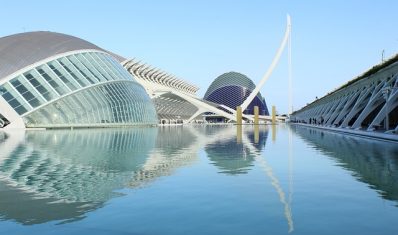
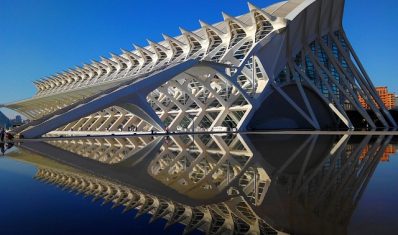
I was intrigued by a poster I found with the words “Sleeping with the Sharks” written on it. I asked Marta and she explained to us that, subject to bookings made in advance, it is possible for schools to book the venue for the night to allow the students to take sleeping bags to sleep in the tunnel under the shark tank. Before going to sleep (or staring at sharks all night), the staff can organise games and treasure hunts to entertain the group. I found this opportunity extremely interesting as it enables students to better understand the behaviour of these incredible animals.
The last building we visited was the Hemisfèric, which is a hi-tech 3D cinema. The main function of this eye-shaped cinema is to project the moving images of IMAX films which exceed the limits of human binocular vision and consequently sucks the viewer into the larger-than-life action. It is an overwhelming sensory experience which enthralled us for two consecutive shows named Mirando lo Invisible (Seeing the Invisible) and Universo Oculto (Hidden Universe).
The Value of new environments
After inspecting hostels during the morning, our last day presented us with a visit to the Bioparc. The Bioparc’s main objective is to promote respect for animals and make the general public aware of the importance of protecting the environment through a commitment to education and the preservation of animals. It replicates the flora and fauna of Africa ranging from open savannahs to the Madagascan forests and everything in between.
Walking back to the hotel to pick up the luggage and head to the airport, we found a nice surprise in the middle of the commercial and industrial area. Campanar – a town within a town. In the past it was one of the many independent towns on the outskirts of Valencia. As soon as Valencia started to expand its territory, the commercial area was slowly swallowing this traditional town to the point that the local government decided to intervene and leave the old town untouched.
Campanar nowadays is an old barrio (neighbourhood) with its typical houses from the 50s in the middle of what became modern Valencia’s commercial area. Whilst you are walking between shopping centres and massive outlets, you can’t help but feel a little nostalgic of times that have come to pass. School groups can walk into Campanar and enjoy its marching band and eat ice cream in the main plaza.

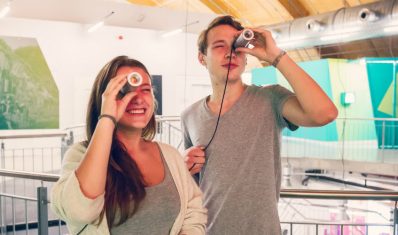
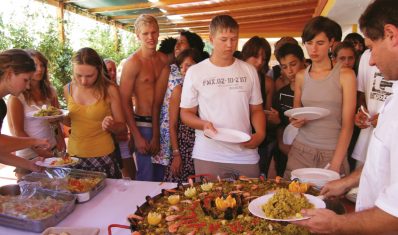
Not lost in translation
The word ‘Valencia’ comes from Latin, meaning ‘strength’ and ‘energy’. This is exactly how I would describe this energetic and vibrant city. It also has the reputation of being a fortunate city because, in comparison to the other big cities in Spain such as Madrid and Barcelona, it has a more privileged natural setting and better weather, and as a result, a better standard of life. I spent just 3 days in the city and I wholeheartedly agree!
There were new excursions every day, each completely different from the last. I am glad I had the chance to visit Valencia and will definitely be recommending it to school groups. I look forward to sharing my insight further with teachers, but until then hasta luego!

Comments are closed here.